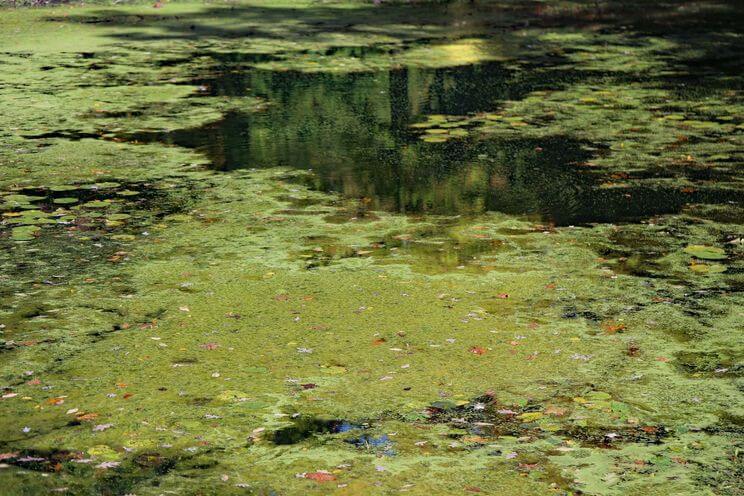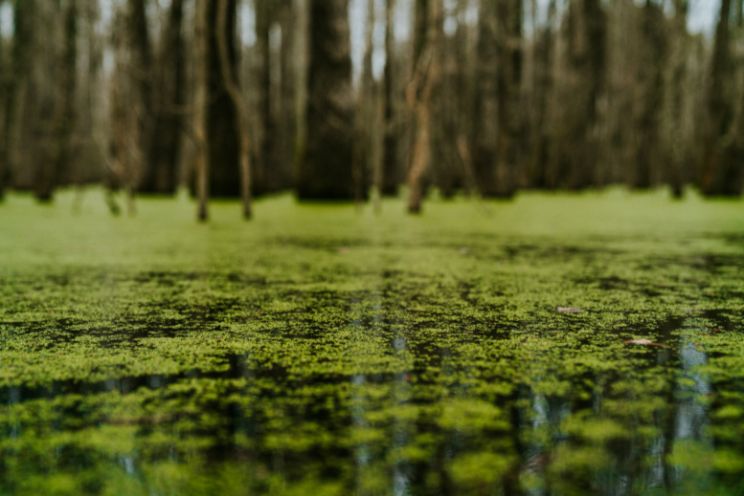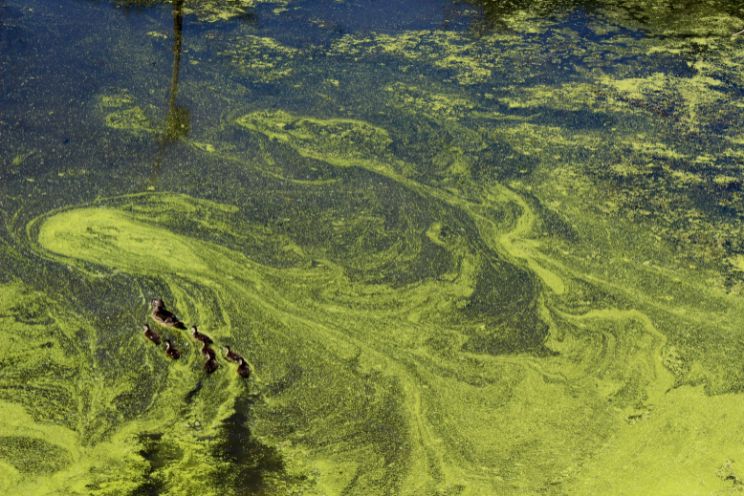There are thousands of different types of algae found all over the world, so chances are, you will definitely encounter some of them if you have a pond.
But, what are some of the common types you may see, are some of them dangerous and why are they growing?

What is pond algae?
Algae is a plant like microorganism, they are tiny cells which grow in vast numbers and form various structures to extract nutrients from the water and light from the sun.
Each type of algae has a different appearance and grows in different ways. Some algaes grow in sheets over a surface, some form little hairy tufts and look like grass, others grow in the water itself and stain it green.
Algae is a main food source for many aquatic organisms because of its abundance across the planet’s ecosystems. It is highly nutritious for fish and aquatic invertebrates, some of whom only eat algae and nothing else.
Goldfish in question actually have a large portion of their diet taken up by algae; it is a main part of their natural diet.
Algae reproduces by separating itself as it grows and or dispersing spores across the water.
This makes algae very good at spreading around, and very successful. Another large part of their success is their simplicity.
Algae are perhaps some of the oldest and simplest organisms on our planet – the ancestors of algae date back to around 1.5 billion years ago, long before animals and plants had evolved!
How does algae get into my pond?
Algae spreads through various means. The most common method many species adopt is to disperse spores – these spores are tiny, they cannot be seen, but are released everywhere in the water column, in the millions.
The spores drift along currents, stick to surfaces and plants and will grow over them, so long as there is light in that area and enough nutrients in the water.
The spores can also be carried around by fish and other aquatic organisms, and even land animals which drink from ponds and lakes can carry the spores.
The most common cause of algae introduction to your pond is actually through birds!
Birds are amazing at spreading seeds and spores across the world, especially since they can fly. They will drink from one body of water, and then visit a different water body, spreading the spores from one to the other.
While this is great for wild ponds, lakes and rivers who the birds bring life to, it may not always be ideal for your goldfish pond.

Is pond algae dangerous?
Nearly all algaes are harmless to animals. However, Cyanobacteria, which is very similar to algae, can produce a mild toxin that in very high amounts can be poisonous.
Algae can however, be of a nuisance to plants, as it grows over their leaves and envelops them, blocking light and nutrients from them, stunting their growth and killing them.
However, a strong healthy plant will often combat algae, as they produce an enzyme which stops spores from growing on their leaves and roots.
Weaker plants and soft leaves plants will often fall victim to aggressive algaes much more than a healthy growing plant.

What is Cyanobacteria?
Blue green algae is the most commonly encountered form of Cyano in freshwater environments, it is very difficult to get rid of and grows rapidly.
It is a relative of algae and behaves in a similar manner, but it is more of a photosynthetic bacteria (a microbe that feeds on light.)
It is identifiable as a thick green/blue slime which coats surfaces, mainly growing on the sand/substrate. It also has a distinct strong smell, which makes it easily recognisable!
There are some treatments for this, but not all are safe for fish and not all of them work effectively.
How does algae grow?
Cyano grows in mostly static environments, or where there is little water movement. It likes to grow in thick blue sheets across the substrate, rocks and plant leaves.
The bacteria/algae itself isn’t really harmful to your fish or you, unless it grows in extremely large quantities. With this said, we do not recommend you drink water with blue green cyano in it, and definitely do not eat the algae.
Always wash your hands after having your hands in a pond or tank containing it, as it can be toxic over time.
Blue green algae is found in nearly every freshwater environment on earth, but it will grow in large amounts in poor water quality. It often grows in neglected planted tanks and ponds.
A good way to try and get rid of it is persistence.
- You should clean your gravel and wipe plant leaves and decor surfaces every day.
- Constantly disturb the algae and increase flow so it struggles to grow.
- You can also perform more water changes, to starve the algae of nutrients.
In short, increase maintenance!
Sometimes you can have a particularly tough algae that wants to stay no matter how much work you put in, in this case, clean your pond or tank even more!
Or you can also add an enzyme treatment to eradicate it, just be careful to follow the rules on the tub, and make sure it is safe for pond life.
Feed your pond less and invite less nutrients, avoid using too much plant fertiliser and you can even place a cover over your pond to remove some light, this will also help reduce the blue green cyano growth.
Do goldfish eat blue green bacteria?
No, your fish won’t eat the blue-green algae. So, if you want to get rid of it, we suggest using the methods mentioned above.
What is floating algae called?
Floating sheets of algae on your pond are called “algae mats”; they can be formed by a number of different species, one of which is blue-green algae!
It usually forms when there is too much sunlight reaching the pond. It causes the algae to pearl, which is when little bubbles of pure oxygen are released by the algae.
These bubbles collect and cause the algae structure to float to the surface, and will appear as green slime floating on top full of air bubbles.
Algae can also float if the pond becomes too warm. In Summer, a soft easily breakable green algae may form on the top of the water. However, this algae is harmless and is often eaten by goldfish, or can be easily removed.
Floating algaes are very common during the summer and aren’t something to be overly worried about.
However, in high amounts, they can block gaseous exchange from occurring and make the pond’s surface stagnant, which can kill your fish from hypoxia, so it should be regularly removed when in high amounts.

Why is identifying algae important?
Knowing what type of algaes are growing in your pond or tank is key to knowing why they are there and it can give you a better understanding of the ecosystem you have created.
For example, if you have an abundance of blackbeard algae, you know that there is an excess amount of iron dissolved in your water, and is perhaps a sign that you should dose less fertiliser with high iron contents, or feed less protein rich foods.
The presence of soft green algae or diatom algae shows there is an imbalance of nutrients in the water, and that there potentially isn’t much flow in the water column.
Identifying blue green algae can also keep you and your pets or children safe, as it can be poisonous to humans when ingested!
What are the different types of algae?
As previously stated, there are tens of thousands of different types of algae, perhaps millions, so there is no way we can cover them all, so we will go over the main and most commonly encountered types of pond and aquarium algae:
String Algae (Blanketweed)
Characterised by dark green hairy growth along surfaces and stuck to plants, this typically grows in ponds with high flow and oxygen. It feeds on nitrates and other minerals in the water, but can be problematic as it grows fast and will clog up a pond’s filter.
Blanketweed can be easily removed by hand and dies off over winter, but will return in summer. It is not commonly eaten by goldfish, but it is possible for your fish to graze on if they are hungry.
Blackbeard Algae
This is commonly encountered in environments with warmer temperatures and water that has high amounts of iron dissolved in it.
It is characterised as little purple or black tufts which grow on wood, rocks and plants, it grows much like grass and spreads over an area.
This algae is not so easily removed as it firmly embeds itself to a surface, but it can be done with chemicals or by reducing the iron levels in the tank.
Not many animals eat this algae, aside from Siamese algae eaters and Siamese flying fox.
Staghorn Algae
Characterised as elongated stringy branches growing from plants or wood, very similar to hear algae, but it has a pale green, yellow or grey appearance.
It is soft to the touch and comes away easily, this normally grows in ponds or tanks with high nutrients and light levels, and low amounts of flow.
This algae is eaten by fish and most invertebrates.
Green Algae
Not to be confused with blue-green algae or green water, green algae describes a large collection of different species which essentially do the same thing. Most green algaes grow along surfaces and on plants, they are a sign the water contains too much nutrients and light.
Some like green hair algae can be easily picked away by hand, but some like green spot algae are very tough, and need to be scraped away with a firm card or blade.
Green spot algae isn’t eaten by anything, other than some types of snails which have teeth strong enough to scrape through it.
However most green algaes are commonly consumed by goldfish and most invertebrates.
Diatom Algae
Diatoms are another lineage of algae, they grow as single cells and spread over surfaces in thin, soft sheets. The main type of diatom algae are brown diatoms, but there are also green diatoms.
Brown diatom algae grows very quickly, particularly in new setups where the ecosystem has not yet been established.
Diatoms are easily removed and can be prevented with frequent water changes, live plants and a proper day-night light cycle.
Diatoms are eaten by a majority of herbivorous freshwater fishes and invertebrates, it is easily digestible and accounts for the majority of many fish species diets.

How to keep pond algae under control
Keeping on top of pond algae is a constant battle, especially during the warm summer months, where there is plenty of sunlight and nutrients!
For some, removing algae every day is a chore they have adopted into their schedule and is part of pond keeping.
Others use different methods to avoid it; some chemical and some biological, it all depends on the individual.
Some chemicals and enzymes can be used to disintegrate algae, however, you must be very careful with these, as not all of them are safe for fish or pond creatures – be very careful to read the bottles and follow the instructions.
If you want to be less risky, biological methods can be used, such as introducing snails or crayfish to a pond that eat algae, just be sure to give them the same amount of care and respect as your fish.
Pond snails are great for keeping on top of algae!

Are there any good types of algae?
Algae are living organisms that have evolved to live in various environments, taking advantage of available nutrients and spaces.
They cannot be categorised into good or bad types, as it is not so simple, and it is not fair to order them like this.
If you want to get really technical about it, then all forms of algae are beneficial in some way, as they consume harmful nitrates, produce oxygen, give cover for fry/ infusoria and provide a food source for aquatic animals!
Looking at it like this, algae seems like a welcome guest to any aquarium or pond.
However, in large quantities, algae can swamp a body of water and turn it toxic very easily. They can suffocate plants, block gaseous exchange and clog up filtration units.
We suggest the idea of keeping it in moderation, having some algae growing in your pond or tank is nothing to worry about, just don’t allow it to take over.
Manageable algaes
We also have a couple algaes that we actually particularly like due to their usefulness.
These algaes are less invasive, are easily manageable and are quite useful.
- Diatom algae is easy to remove, consumes nitrates quickly and is an amazing food source for fry and picky algae eaters, like otocinclus, hillstream loach, baby plecostomus and cardinal shrimp.
- Green spot algae can be a really good nitrate and ammonia remover!
While it cannot be eaten by anything, it keeps the water clean, prevents other more invasive algaes from growing and can look aesthetically pleasing, especially if it grows on terracotta or smooth pebbles.
However, it is a pain to remove as it embeds itself to glass and wood, but it can not clog pipes or block open spaces!
- Filamentous green hair algae is a variety of soft green algae that grows on plants and surfaces, it grows quickly and can clog up a tank, but it is an amazing food for snails, shrimp, goldfish, livebearers, plecos and is great for housing fry and infusoria!
There are also shorter varieties of this algae which can also look quite nice grown on wood and rocks, making your tank look like a miniature grassy plateau.
